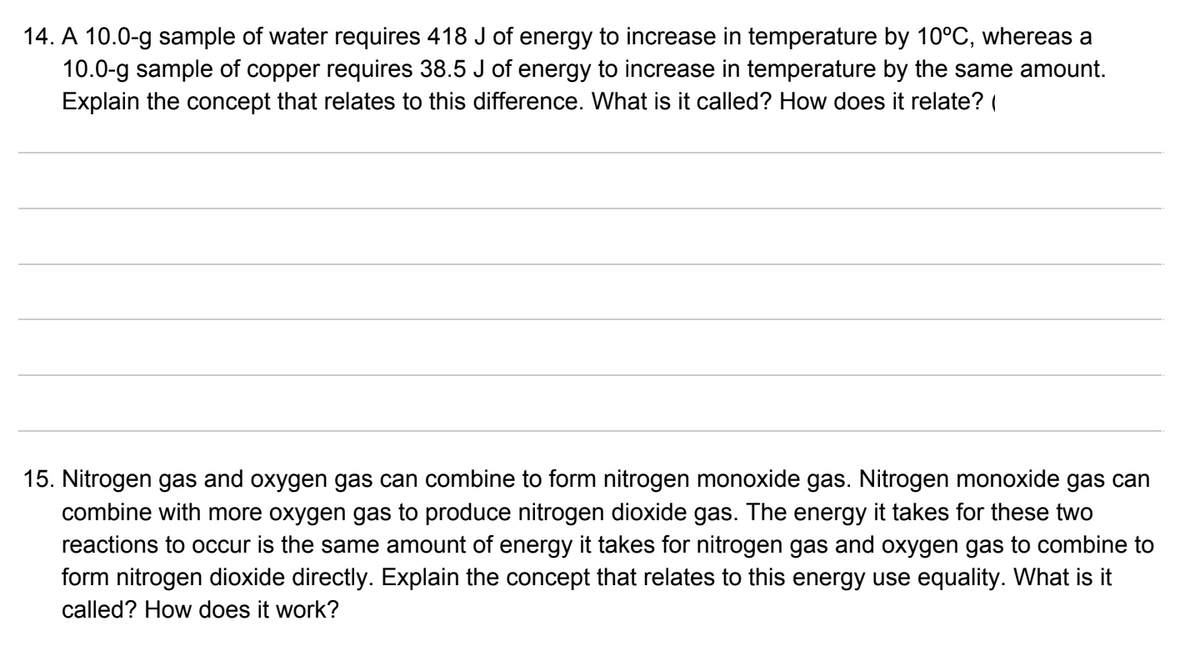14. A 10.0-g sample of water requires 418 J of energy to increase in temperature by 10°C, whereas a 10.0-g sample of copper requires 38.5 J of energy to increase in temperature by the same amount. Explain the concept that relates to this difference. What is it called? How does it relate? (
14. A 10.0-g sample of water requires 418 J of energy to increase in temperature by 10°C, whereas a 10.0-g sample of copper requires 38.5 J of energy to increase in temperature by the same amount. Explain the concept that relates to this difference. What is it called? How does it relate? (
Chemistry for Engineering Students
4th Edition
ISBN:9781337398909
Author:Lawrence S. Brown, Tom Holme
Publisher:Lawrence S. Brown, Tom Holme
Chapter9: Energy And Chemistry
Section: Chapter Questions
Problem 9.103PAE: 9.103 One reason why the energy density of a fuel is important is that to move a vehicle one must...
Related questions
Question

Transcribed Image Text:14. A 10.0-g sample of water requires 418 J of energy to increase in temperature by 10°C, whereas a
10.0-g sample of copper requires 38.5 J of energy to increase in temperature by the same amount.
Explain the concept that relates to this difference. What is it called? How does it relate? (
15. Nitrogen gas and oxygen gas can combine to form nitrogen monoxide gas. Nitrogen monoxide gas can
combine with more oxygen gas to produce nitrogen dioxide gas. The energy it takes for these two
reactions to occur is the same amount of energy it takes for nitrogen gas and oxygen gas to combine to
form nitrogen dioxide directly. Explain the concept that relates to this energy use equality. What is it
called? How does it work?
Expert Solution
This question has been solved!
Explore an expertly crafted, step-by-step solution for a thorough understanding of key concepts.
Step by step
Solved in 3 steps with 1 images

Knowledge Booster
Learn more about
Need a deep-dive on the concept behind this application? Look no further. Learn more about this topic, chemistry and related others by exploring similar questions and additional content below.Recommended textbooks for you

Chemistry for Engineering Students
Chemistry
ISBN:
9781337398909
Author:
Lawrence S. Brown, Tom Holme
Publisher:
Cengage Learning

General Chemistry - Standalone book (MindTap Cour…
Chemistry
ISBN:
9781305580343
Author:
Steven D. Gammon, Ebbing, Darrell Ebbing, Steven D., Darrell; Gammon, Darrell Ebbing; Steven D. Gammon, Darrell D.; Gammon, Ebbing; Steven D. Gammon; Darrell
Publisher:
Cengage Learning

Chemistry for Engineering Students
Chemistry
ISBN:
9781285199023
Author:
Lawrence S. Brown, Tom Holme
Publisher:
Cengage Learning

Chemistry for Engineering Students
Chemistry
ISBN:
9781337398909
Author:
Lawrence S. Brown, Tom Holme
Publisher:
Cengage Learning

General Chemistry - Standalone book (MindTap Cour…
Chemistry
ISBN:
9781305580343
Author:
Steven D. Gammon, Ebbing, Darrell Ebbing, Steven D., Darrell; Gammon, Darrell Ebbing; Steven D. Gammon, Darrell D.; Gammon, Ebbing; Steven D. Gammon; Darrell
Publisher:
Cengage Learning

Chemistry for Engineering Students
Chemistry
ISBN:
9781285199023
Author:
Lawrence S. Brown, Tom Holme
Publisher:
Cengage Learning

World of Chemistry, 3rd edition
Chemistry
ISBN:
9781133109655
Author:
Steven S. Zumdahl, Susan L. Zumdahl, Donald J. DeCoste
Publisher:
Brooks / Cole / Cengage Learning

Introductory Chemistry: A Foundation
Chemistry
ISBN:
9781337399425
Author:
Steven S. Zumdahl, Donald J. DeCoste
Publisher:
Cengage Learning

Chemistry by OpenStax (2015-05-04)
Chemistry
ISBN:
9781938168390
Author:
Klaus Theopold, Richard H Langley, Paul Flowers, William R. Robinson, Mark Blaser
Publisher:
OpenStax